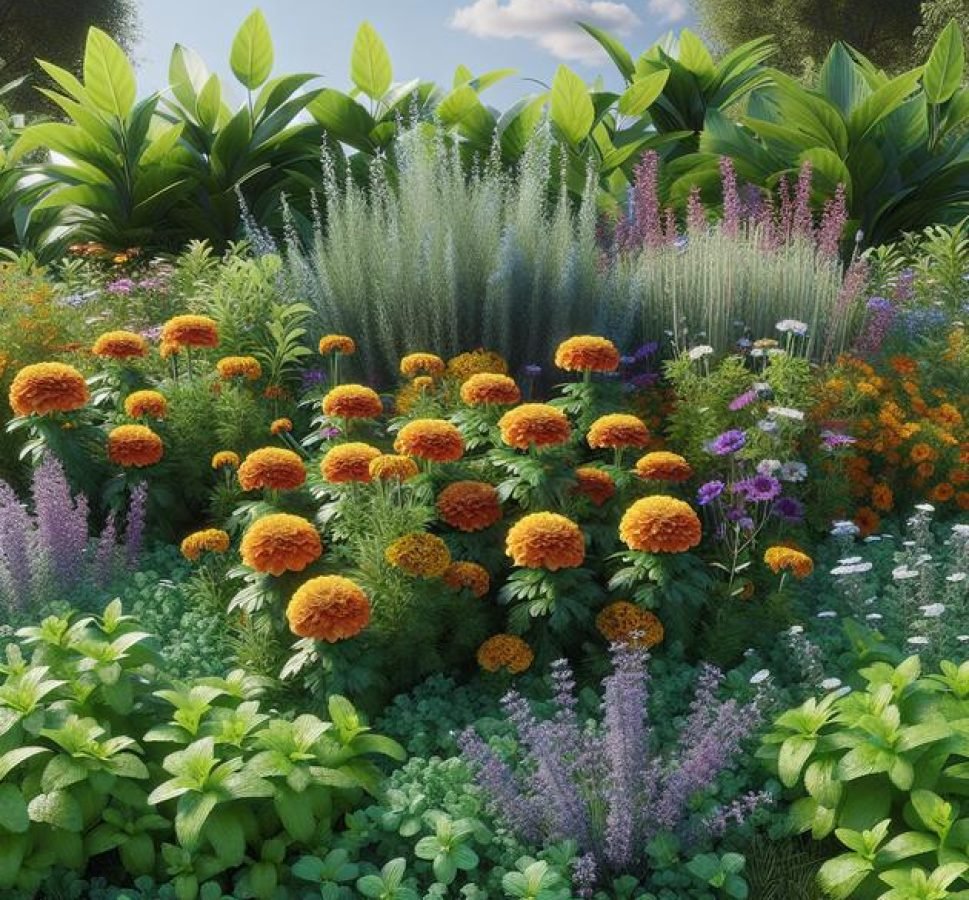Natural pest control outdoor uses beneficial insects, pest-repellent plants, homemade remedies, and healthy soil practices to manage pests safely and sustainably without chemicals.
The natural pest control outdoor approach invites us to rethink how we handle those unwanted garden visitors. Ever wondered if there’s a gentler, more earth-friendly way to keep your outdoor spaces thriving? Let’s dive into tips that make sense and feel right for your plants and the planet.
understanding natural pest control
Natural pest control is an eco-friendly method that relies on biological and environmental factors to manage pests in outdoor spaces. Instead of using harmful chemicals, it encourages the use of nature’s own balance to keep pest populations low and protect your plants. This approach includes promoting predators like ladybugs and spiders that feed on harmful insects, and maintaining healthy soil that supports strong plants more resistant to pests.
Why Choose Natural Pest Control?
Natural pest control reduces the risk of chemical exposure to humans, pets, and beneficial wildlife. It also prevents pollution of soil and water. By using natural methods, gardeners create a sustainable environment that supports biodiversity and long-term pest management.
Key Principles
This method focuses on enhancing natural predator-prey relationships, encouraging diverse plantings, and practicing good garden hygiene. Avoiding broad-spectrum pesticides helps maintain the population of beneficial insects. Crop rotation and companion planting are examples of cultural practices that disrupt pest life cycles.
Understanding these core concepts helps gardeners adopt solutions tailored to their specific outdoor environment, making natural pest control both practical and effective.
common outdoor pests and their impact
Outdoor spaces can attract a variety of pests that may harm plants and disrupt the balance of your garden. Some common pests include aphids, caterpillars, slugs, and spider mites. These insects feed on leaves, stems, and roots, causing damage like wilting, discoloration, or stunted growth.
Identifying Key Pests
Aphids are small, soft-bodied insects that cluster on new growth and suck sap from plants. They can spread diseases and attract ants. Caterpillars chew large holes in leaves and can quickly defoliate a plant if not controlled.
Slugs thrive in damp environments and feed on tender leaves and seedlings, often leaving irregular holes. Spider mites are tiny pests that create fine webs on the undersides of leaves, causing yellowing and leaf drop.
Impact on Outdoor Spaces
These pests weaken plants by reducing their ability to photosynthesize and absorb nutrients. This stress makes plants more vulnerable to diseases. Severe infestations can lead to loss of flowers, fruits, and even plant death, affecting the overall health and appearance of your garden.
Understanding the behavior and signs of common outdoor pests is crucial for timely and effective control using natural methods.
beneficial insects: your garden allies

Beneficial insects play a crucial role in natural pest control by preying on harmful pests that damage your plants. These helpful allies include ladybugs, lacewings, spiders, and predatory wasps. They help reduce pest populations without the need for chemical pesticides.
Ladybugs and Lacewings
Ladybugs are especially effective against aphids, which they consume in large quantities. Lacewing larvae, sometimes called “aphid lions,” also feed on aphids, caterpillars, and other soft-bodied pests, helping to keep your garden balanced.
Spiders and Predatory Wasps
Spiders trap a variety of insects in their webs, acting as natural pest barriers. Predatory wasps hunt and paralyze pests like caterpillars and beetle larvae, preventing them from harming your plants. They do not pose a threat to humans when left undisturbed.
Encouraging these insects by planting diverse flowers and avoiding broad-spectrum insecticides creates a thriving outdoor ecosystem. Understanding how to attract and protect these natural predators empowers gardeners to maintain healthy, pest-resistant gardens.
using plants to repel pests naturally
Certain plants act as natural repellents by emitting scents or chemicals that pests dislike. Integrating these plants into your outdoor space can create a protective barrier that reduces pest problems without harmful chemicals.
Common Pest-Repelling Plants
Marigolds are known to deter nematodes and aphids with their strong scent. Lavender repels moths, fleas, and mosquitoes, while basil drives away flies and mosquitoes. Mint can also prevent ants and aphids but should be planted carefully as it spreads quickly.
Companion Planting Strategies
Growing pest-repelling plants alongside vulnerable crops strengthens your garden’s defense. For example, planting garlic near roses helps repel aphids, and onions near carrots reduce carrot fly infestations. This method enhances both pest control and overall plant health.
By using nature’s own defense system, gardeners can protect their plants efficiently while supporting pollinators and beneficial insects that thrive alongside repellent plants.
homemade remedies that actually work
Many effective homemade remedies use simple ingredients to control pests in your outdoor spaces without chemicals. These solutions are often safe, affordable, and easy to prepare.
Soap Spray
A mixture of mild liquid soap and water can be sprayed on plants to suffocate soft-bodied insects like aphids and mites. Use about one tablespoon of soap per quart of water and apply it directly to affected leaves.
Garlic and Chili Spray
Blending garlic or chili peppers with water creates a natural insect repellent. This spray deters a wide range of pests due to its strong scent. Strain the mixture and spray on plants weekly or after rain.
Neem Oil
Neem oil is a natural pesticide extracted from the neem tree. It disrupts insect growth and feeding. Dilute neem oil with water according to package instructions and spray on plants to control a variety of pests.
These homemade remedies are best used early in the pest cycle and combined with other natural pest control methods for the best results.
composting and soil health for pest resistance

Healthy soil is the foundation of a strong garden that can resist pests naturally. Composting enriches soil by adding organic matter and beneficial microbes. This improves soil structure, moisture retention, and nutrient availability for plants.
Role of Compost in Pest Resistance
Compost encourages a thriving soil ecosystem where beneficial organisms outcompete harmful pests. These microbes can help suppress soil-borne diseases and improve plant health, making plants less vulnerable to insect attacks.
Improving Soil Health
Adding compost regularly boosts soil fertility and promotes root growth, which strengthens plants. Well-nourished plants develop natural defenses against pests and recover more easily from damage.
Incorporating compost into your gardening routine supports long-term pest control by creating a vibrant, balanced environment where both soil and plants thrive.
how to create a pest-friendly outdoor habitat
Creating a pest-friendly outdoor habitat means encouraging natural predators and beneficial insects to thrive, which helps control harmful pests naturally. This involves providing food, water, shelter, and suitable plants that attract helpful wildlife.
Plant Diversity
Planting a variety of flowers and shrubs offers nectar and pollen for beneficial insects like bees and butterflies. Native plants are especially good at supporting local ecosystems and providing habitats for predatory insects that keep pests in check.
Water and Shelter
Providing shallow water sources, such as small birdbaths or dishes with stones, attracts birds and insects that prey on pests. Additionally, leaving natural debris like logs and leaf litter creates hiding places for spiders, ground beetles, and other helpful creatures.
Maintaining an environment without harsh chemicals allows these allies to flourish, creating a natural balance that reduces pest outbreaks and promotes plant health.
monitoring and maintaining pest control naturally
Regular monitoring is essential for effective natural pest control. By inspecting plants often, you can detect pest problems early and take action before they spread. Use a magnifying glass to check under leaves and look for egg clusters, webs, or damage signs.
Record Keeping
Keeping detailed records of pest occurrences helps you understand patterns and effectiveness of control methods. Note dates, pest types, and control measures used to improve your approach over time.
Maintaining Natural Pest Control
Maintaining healthy plants through proper watering, feeding, and pruning supports their natural defenses. Encourage beneficial insects continuously by providing diverse plants and avoiding broad-spectrum pesticides. Rotate crops and remove affected plant parts promptly to reduce pest habitats.
Consistent attention and care create a resilient outdoor space where natural pest control thrives, reducing the need for chemical interventions.
Embracing natural pest control for a healthier garden
Natural pest control offers safe and sustainable ways to protect your outdoor spaces without harmful chemicals. By understanding pests, encouraging beneficial insects, and using plants and homemade remedies, you create a balanced garden ecosystem.
Maintaining healthy soil and monitoring your garden regularly ensures long-term pest resistance. Small efforts in creating a pest-friendly habitat pay off with healthier plants and a beautiful outdoor space.
Choosing natural methods not only benefits your garden but also helps protect the environment. Start incorporating these practices today and enjoy a thriving, pest-free garden all season long.





